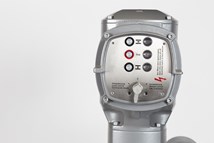Green Stands for $$
Some states — California, in particular — are imposing ever-more-severe restrictions on emissions of everything from carbon dioxide to diesel particulates, and the costs to industry promise to be high.
Infrastructure
An important and long-neglected part of the nation's infrastructure is water and wastewater, and during the election campaign Mr. Obama spoke about encouraging work on water conservation and desalination. How much of this is campaign rhetoric and how much he will attempt to implement are unknown, but according to a survey by the American Public Works Association there are more than 3,600 unfunded local public works infrastructure projects totaling more than $15 billion that are ready to go within 90 days and would generate approximately 532,794 jobs.
When examining all infrastructure projects, the figures are even more staggering. According to the U.S. Conference of Mayors, which in December released its second installment of "Ready-to-Go" infrastructure projects, 427 cities have reported a total of 11,291 infrastructure projects costing approximately $73 billion. If authorized, these projects would create 847,641 jobs. You can view the database of projects on the U.S. Conference of Mayor's Mainstreet Economic Recovery website.
(Editor's note: Watch for a feature article on the nation's deteriorating water infrastructure in the spring 2009 issue of Valve Magazine.)
Renewable energy
While petroleum prices are low right now, they won't stay that way as economic activity picks up again. Rising oil prices encourage alternative fuels, but not all areas are worth exploring. One I might be inclined to avoid is ethanol, biodiesel or any food crop-based alternate energy scheme. In the long run turning food into fuel doesn't seem like a viable strategy, given the world's ever-growing population. And while cellulose-based fuels may look attractive at the moment (if the technology can be perfected), there's only so much corn stover and wheat straw available, while the space to grow switchgrass is finite. There is something to be said for algae, because it can be grown inside plastic tubes in the desert and doesn't use any cropland, but commercial viability is years away.
The big problem for industry is that none of this is likely to happen soon. Global Trends 2025: A Transformed World, published by the National Intelligence Council, notes, "In the energy sector, a recent study found that it takes an average of 25 years for a new production technology to become widely adopted."
Green manufacturing
"Green manufacturing" applies to how manufacturers produce products with the least possible impact on the environment, but as more and more companies get on the green bandwagon, suppliers of components may well benefit. President-elect Obama has indicated a desire to encourage green technology, and if the federal government has any money available (which is far from certain, given the huge sums already allocated for various bailouts) some will probably be directed to green projects. If there's no federal money available the money would have to come from private sources - which in turn depends on the credit situation unfreezing.
Reducing one's carbon footprint
Another item likely to be high on the agenda of the incoming administration is global warming. In connection with that, I listened on Dec. 11 to a presentation entitled "How Carbon is Greening Manufacturing," by Keith McCoy, VP, Energy Resources and Policy at the National Association of Manufacturers at the Virtual Energy Forum (a trade show held entirely in cyberspace). McCoy is NAM's senior lobbyist before Congress and the administration on energy, climate change and other environmental issues, and he had some interesting things to say. He started by pointing out that the U.S. manufacturing sector consumes a third of all energy used in the country, with petroleum and especially natural gas being the largest portion of that, and that 59% of renewables go to electricity production.
McCoy pointed out that many states are putting renewable energy and greenhouse gas reduction mandates in place. At the moment these tend to be on a state-by state basis, but he expects to see a federal mandate coming down, perhaps early next year. Companies and utilities, he said, "are looking at that and wondering how to get ahead of that curve, how to do capital spending and planning now." We'll likely see companies first try to reduce their footprints in ways that will save them money; it's only later, he continued, that "other things start to kick in in terms of environmental and good citizenship."
McCoy cited as an aid to planning the so-called McKinsey curve, which appears in an article entitled "A Cost Curve for Greenhouse Gas Reduction," in The McKinsey Quarterly 2007 Number 1. The curve ranks different greenhouse gas (GHG) abatement measures in terms of their expected cost. Some abatement measures, like adding insulation and improving energy efficiency have a positive return, while others, like industrial feedstock substitution and use of biodiesel, have net costs. "We would probably support such things as carbon capture/sequestration, new clean coal power facilities," said McCoy.
One of McCoy's larger points was that a state-by-state approach "is a regulatory nightmare for companies." The ideal situation, he feels, would be federal legislation that pre-empts state laws, although there remains the problem of international competition: "If we have a climate change legislation here in the United States and then there isn't similar climate change legislation in China [for companies] creating similar products, then that [puts] American manufacturers at a competitive disadvantage." What's needed, he continued, would be "some type of mechanism that levels the playing field from an international perspective."
The international situation is far from settled at this point. On Dec. 12, at the United Nations Climate Change Conference in Poznań, Poland, European leaders agreed, after two years of haggling, on how the EU will, by 2020, reduce greenhouse gas emissions by 20% compared with 1990 levels, reduce energy consumption by 20% and ensure that 20% of the EU's energy comes from renewable sources. Final agreements are scheduled for Copenhagen in December of 2009.
Yet on the same day the International Herald Tribune carried a Reuters' story that the European Union had pushed back to 2020 the date at which electric utilities in East European countries would have to begin paying for all their required carbon permits, from the original date of 2013. In addition, "heavy industry sectors like steel and chemicals would receive free emissions permits if they can show their costs are increasing and that they are significantly exposed to international competition."
For further information
The next Virtual Energy Forum will be held June of 2009, and presentations from the last one will be available for a while online. You might also want to attend one of the Green Manufacturing Expos in your area; they're scheduled for Anaheim, CA in February; Charlotte, NC in March; New York City in June; and Rosemont, IL in September.
A final word
The drawback (or opportunity, if you prefer) of state-by-state regulation is illustrated by a story I read some years ago. An industrial company in California was under severe pressure from state regulators to reduce its chemical discharges. After much back and forth the company president sent in a report stating that it had reduced its discharges to zero.
A state official called the president to congratulate him. "That's wonderful," she said. "How did you do it?"
"We closed the facility, fired all the employees and moved the business to Nevada."
Peter Cleaveland is technical editor for Valve Magazine. Reach him at pcleaveland@earthlink.net.
The California Example
As an example of how extensive some state regulations can be, take a look at what has happened recently in California:
On Dec. 11 the California Air Resources Board (ARB) approved a plan to reduce the state's greenhouse gas emissions to 1990 levels by 2020. Measures to meet the goal cover a wide range, with a carbon cap-and-trade system envisioned covering 85% of the state's emissions. Other recommendations include energy efficiency programs, clean cars standards, increases in the use of clean and renewable energy and implementation of a low-carbon fuel standard.
The next day ARB adopted two more regulations, these aimed at diesel trucks. Beginning Jan. 1, 2011, the Statewide Truck and Bus Regulation will require truck owners to install diesel exhaust filters on their rigs, with nearly all vehicles to be upgraded by 2014. Owners must also replace engines older than the 2010 model year according to a staggered implementation schedule that extends from 2012 to 2022.
The Heavy Duty Vehicle Greenhouse Gas Emission Reduction Measure requires long-haul truckers to install fuel-efficient tires and aerodynamic devices on their trailers that lower greenhouse gas emissions and improve fuel economy.
On the industrial side, the Proposed Scoping Plan (PSP) will "require assessment of large industrial sources to determine whether individual sources within a facility can cost-effectively reduce greenhouse gas emissions and provide other pollution reduction co-benefits. Reduce greenhouse gas emissions from fugitive emissions from oil and gas extraction and gas transmission. Adopt and implement regulations to control fugitive methane emissions and reduce flaring at refineries."
There are specific energy efficiency audit requirements covering major industrial facilities emitting more than 0.5 MMTCO2E per year. The audit would apply to "individual combustion and other direct sources of greenhouse gases within the facility to determine the potential reduction opportunities, including criteria air pollutants and toxic air contaminants," in the words of the PSP, as well as "an assessment of the impacts of replacing or upgrading older, less efficient units such as boilers and heaters, or replacing the units with combined heat and power (CHP) units."
For the oil and gas industry there are proposed regulations on oil and gas extraction GHG emissions, GHG leak reduction from oil and gas transmission, refinery flare recovery process improvements and removal of the methane exemption from existing refinery regulations.
While many look with dismay at the expected costs, ARB insists the plan will be an economic boon. "It will guide capital investments into energy efficiency to save us money, into renewable energy to break our dependence on oil, and promote a new generation of green jobs for hundreds of thousands of Californians," said ARB Chairman Mary Nichols. And the PSP even has specific estimates of increases in venture capital investment in the state. How realistic they are is anybody's guess.
RELATED CONTENT
-
General Considerations for Control and Choke Valves Used in Offshore Oil and Gas Production
The application of control and choke valves used in offshore oil and gas production is a very broad field and in this article, some of the main considerations for valve selection will be addressed.
-
Metal Additive Manufacturing: the Evolving Road to Adoption and Standardization
Greater knowledge and acceptance of metal AM valve components—especially with various standardization efforts underway—will spur the technology’s growth.
-
The Biggest Valves: Sizes Growing in Step with Greater Demand
Valve manufacturers that have the expertise, skills, equipment and facilities to produce large valves are rare.







 Unloading large gate valve.jpg;maxWidth=214)


